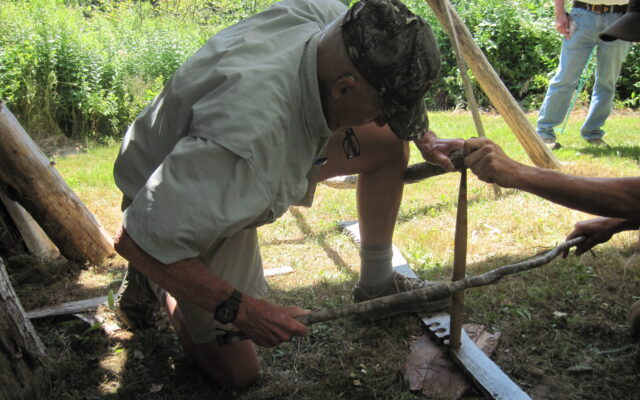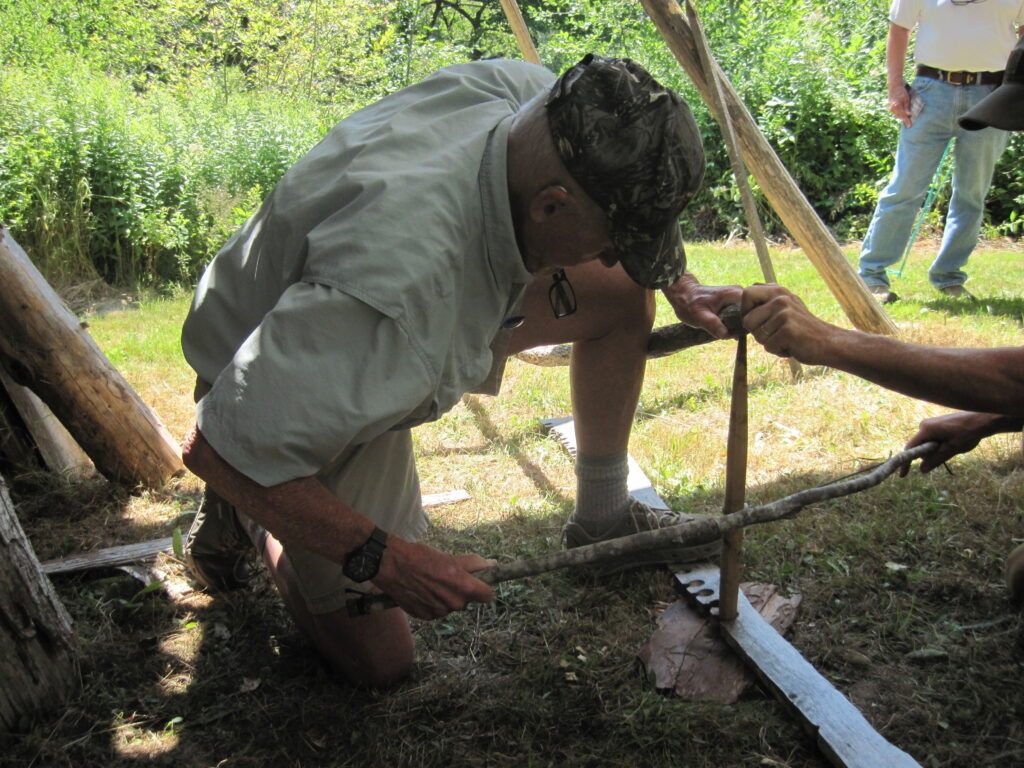
This ancient survival skill might save you in the Maine woods
By V. Paul Reynolds
How would you like to learn a skill that was practiced by your ancestors during the Neolithic era more than 5,000 years ago, and uses the same basic materials?
A bow drill is the oldest known human invention for starting a fire by friction. Many years ago, as a Boy Scout, I tried unsuccessfully to start a fire with a bow drill, and, sad to say, wound up using a Bic lighter to get a camp fire going.
The good news is that last month at the Puckerbrush Primitive Gathering at the Pleasant River Fish & Game Conservation Association I had a redemptive moment with the bow drill.

BOW DRILLING — The author learning to start a fire with a primitive bow drill at the Puckerbrush gathering recently in Columbia Falls. Tim Beal, from Whiting, taught Reynolds the finer points of bow drilling, an ancient fire starting method that dates back 5,000 years.
Thanks to the patient tutoring and step-by-step instruction of Tim Beal, it all came together for me in a soul-satisfying, smoking ember that finally ignited and shot out a red flame from the tinder “bird’s nest.”
Beal, who is a timber framer, farmer and blueberry grower from Whiting, knows his craft, not only with a bow drill, but with patient and focused instruction. Starting a fire with mere friction is not quite as easy as it sounds. There are a lot of parts: the spindle, the hearth board, the bearing block, the bow and the string.
As Beal emphasizes, methodical preparation is half the battle. Good tinder is the key, and can be derived from a variety of sources. As for the bow drill itself, he says cedar or balsam fir is the best – their softwood properties create the fine dust and friction heat needed for ember formation.
He lubricates the top of the spindle and makes sure that the burn end of the spindle is carved into a blunt point. Using the bow drill to rotate the spindle back and forth, he first burns a hole into the hearth board.
Then he cuts a pie-shaped notch in the side of the hole, creating a channel for the glowing embers to fall onto a dry surface below. Once the embers collect on the bark, you gently nestle them with dry punk wood, then surround the growing coal with your prepared tinder “bird’s nest.” A few gentle puffs of breath and voila – you have fire.
The other primitive method of fire starting, along with the friction process, is called “percussion starting,” which involves striking flint over tinder.
Otzi, the 5,000 year old hunter found frozen in the Alps a while back, was not carrying a bow drill. He was a percussion guy who carried flint and pyrite. Pyrite is another name for a mineral called “fool’s gold.”
The mountain man may have been primitive, but he knew enough to coddle his precious fire source. Experts determined that he actually transported smoking embers in a leather pouch as he wandered about changing campsites.
Of course, it’s one thing to start a bow-drill fire under ideal conditions. It’s quite another if you are, say, the doomed trapper in Jack London’s classic short story, “To build a fire.” London’s character got a life-saving fire blazing at 50 below zero only to have it smothered out by a lump of snow falling from an overhanging branch.
When it comes to survival, whether it was the Ice Man of 5,000 years ago, the Klondike trapper of the 1800s or a lost hunter or hiker in the 21st century, the capacity to start a fire often remains the difference between life and death.